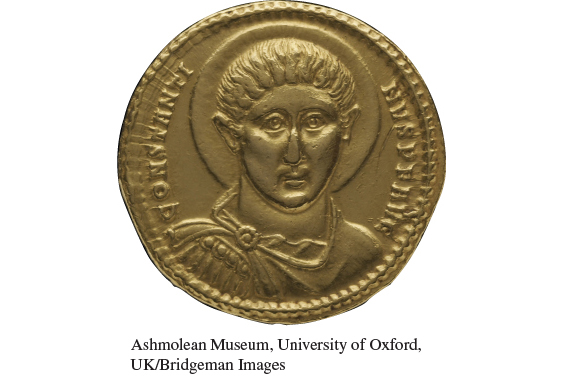A History of Western Society: Printed Page 187
A History of Western Society, Value Edition: Printed Page 175
A History of Western Society, Concise Edition: Printed Page 187
Economic Issues

Diocletian and Constantine were faced with a number of economic problems, including inflation and declining tax revenues, and their attempts to solve them illustrate the methods and limitations of absolute monarchy. In a move unprecedented in Roman history, Diocletian issued an edict that fixed maximum prices and wages throughout the empire. He and his assistant emperors dealt with the tax system just as strictly and inflexibly. Taxes became payable in kind, that is, in goods such as grain, sheep, or cloth instead of money, which made them difficult to transport to central authorities. Constantine continued these measures and also made occupations more rigid: all people involved in the growing, preparation, and transportation of food and other essentials were locked into their professions. A baker, for example, could not go into any other business, and his son took up the trade at his death. In this period of severe depression many individuals and communities could not pay their taxes. In such cases local tax collectors, who were also bound to their occupations, had to make up the difference from their own funds. This system soon wiped out a whole class of moderately wealthy people and set the stage for the lack of social mobility that was a key characteristic of European society for many centuries to follow.
The emperors’ measures did not really address Rome’s central economic problems, however. Because of worsening conditions during the third and fourth centuries, many free farmers and their families were killed by invaders or renegade soldiers, fled the land to escape the barbarians, or abandoned farms ravaged in the fighting. Consequently, large tracts of land lay deserted. Landlords with ample resources began at once to reclaim as much of this land as they could, often hiring back the free farmers who had previously worked the land as paid labor or tenants. The huge villas that resulted were self-
Free farmers who remained on the land were exposed to the raids of barbarians or robbers and to the tyranny of imperial officials. In return for the protection and security landlords could offer, small landholders gave over their lands and their freedom. To guarantee a supply of labor, landlords denied them freedom to move elsewhere. Henceforth they and their families worked their patrons’ land, not their own. Free men and women were becoming tenant farmers bound to the land, what would later be called serfs.